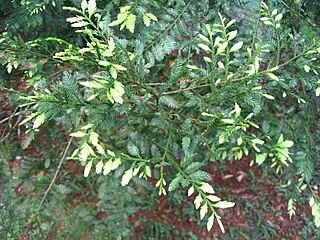
An aril, also called an arillus, is a specialized outgrowth from a seed that partly or completely covers the seed. An arillode or false aril is sometimes distinguished: whereas an aril grows from the attachment point of the seed to the ovary, an arillode forms from a different point on the seed coat. The term "aril" is sometimes applied to any fleshy appendage of the seed in flowering plants, such as the mace of the nutmeg seed. Arils and arillodes are often edible enticements that encourage animals to transport the seed, thereby assisting in seed dispersal. Pseudarils are aril-like structures commonly found on the pyrenes of Burseraceae species that develop from the mesocarp of the ovary. The fleshy, edible pericarp splits neatly in two halves, then falling away or being eaten to reveal a brightly coloured pseudaril around the black seed.

Podocarpaceae is a large family of mainly Southern Hemisphere conifers, comprising about 156 species of evergreen trees and shrubs. It contains 19 genera if Phyllocladus is included and Manoao and Sundacarpus are recognized.

Dacrycarpus is a genus of conifers belonging to the family Podocarpaceae. The genus includes nine species of dioecious evergreen trees and shrubs to 55–60 metres (180–197 ft) in height.

Dacrycarpus dacrydioides or kahikatea is a coniferous tree endemic to New Zealand.

MacGregor's honeyeater also known as giant wattled honeyeater, MacGregor's giant honeyeater, MacGregor's bird of paradise, and ochre-winged honeyeater, is a large black crow-like bird with large orange-yellow eye-wattles and black-tipped, ochre primary wing feathers. The sexes are similar, with the male being slightly larger than the female. It is the only member of the genus Macgregoria.
Aphanocalyx microphyllus subsp. compactus is a tropical rainforest tree in the family Fabaceae. This subspecies is endemic to the western Guinean lowland forests of Ivory Coast, Liberia, and Sierra Leone. The nominal subspecies Aphanocalyx microphyllus subsp. microphyllus occurs in the rainforests of central Africa.
Dacrycarpus cinctus is a species of conifer in the family Podocarpaceae. It is found in Indonesia and Papua New Guinea.
Dacrycarpus cumingii is a species of conifer in the family Podocarpaceae. It is found in Indonesia, Malaysia, and the Philippines.
Dacrycarpus expansus is a species of conifer in the family Podocarpaceae. It is found only in Papua New Guinea.

Dacrycarpus imbricatus is a species of conifer in the family Podocarpaceae. It is found in Cambodia, China, Fiji, Indonesia, Laos, Malaysia, Papua New Guinea, the Philippines, Thailand, Vanuatu, and Vietnam. It is a tall tree up to 40 metres (130 ft) high.
Dacrycarpus kinabaluensis is a species of shrubby conifer in the family Podocarpaceae. It is found only on Mount Kinabalu in Sabah, Malaysian Borneo.
Dacrycarpus steupii is a species of conifer in the family Podocarpaceae.
Dacrycarpus vieillardii is a species of conifer in the family Podocarpaceae. It is found only in New Caledonia.

The Gulf Coast kangaroo rat is a species of rodent in the family Heteromyidae found in Mexico and the state of Texas in the United States. Its appearance and ecology are very similar to those of its putative sister species, Ord's kangaroo rat.
Radiodiscus compactus is a species of small air-breathing land snail, a terrestrial gastropod mollusk in the family Charopidae. This species is endemic to Brazil.

Alectryon macrococcus, known as ʻAlaʻalahua or Māhoe in Hawaiian, is a species of flowering tree in the soapberry family, Sapindaceae, that is endemic to Hawaii.
Phlegmariurus compactus is a species of plant in the family Lycopodiaceae. It is endemic to Ecuador, where it is distributed throughout the southern Andean páramos. It occurs up to 4500 meters in altitude.
Melicope mucronulata is a species of plant in the family Rutaceae. It is endemic to the Hawaiian Islands. It is threatened by habitat loss. It is a federally listed endangered species of the United States. Like other Hawaiian Melicope, this species is known as alani.

Erigeron compactus is a species of flowering plant in the daisy family known by the common names cushion daisy, fernleaf fleabane, and compact daisy.

Xylosandrus compactus is a species of ambrosia beetle. Common names for this beetle include black twig borer, black coffee borer, black coffee twig borer and tea stem borer. The adult beetle is dark brown or black and inconspicuous; it bores into a twig of a host plant and lays its eggs, and the larvae create further tunnels through the plant tissues. These beetles are agricultural pests that damage the shoots of such crops as coffee, tea, cocoa and avocado.









